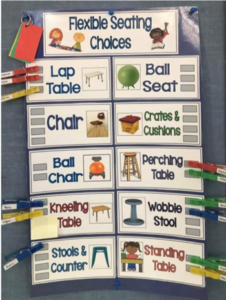Competency:
- Teacher will learn about supports that can be included in a sensory smart classroom to help students with and without exceptionalities.
Mrs. Cargnelli from Merritt Central Elementary let me come and check out her classroom. I was shown what flexible seating options she provided, how she managed the seating, and the classroom norms on flexible seating.
Reflection:
In EDIE 4100 sensory smart classrooms were discussed, and examples were provided. I pondered these examples and decided to do some further research. I opted to reflect on flexible seating, as it fits a sensory smart classroom and through the B.Ed program flexible seating was discussed in multiple courses, but due to Covid-19 I had not had the chance to experience it in any of my practicums. Mrs. Cargnelli from Merritt Central Elementary let me come and check out her classroom. I was shown what flexible seating options she provided, how she managed the seating, and the classroom norms on flexible seating. I chose to reflect on this experience for the portfolio assignment.
In practicum 3200 I saw how students, even grade sevens, have a difficult time sitting in a desk and chairs. One particular student would get up and walk around the room, and another needed movement breaks in order to stay seated. These students reinforced that an inclusive classroom meets students’ needs through providing flexible seating. With my practicum experience in mind, I reflected on the options Mrs. Cargnelli implemented. She used lap tables, ball chairs, kneeling tables, stools, ball seats, crates and cushions, perching tables, wobble stools, and standing tables. I was reminded that there are countless alternatives to desks and chairs!
Seating arrangements can greatly influence the mood and behaviours in a classroom. During my 3200 practicum my teacher mentor changed from desk rows to pods, and the outcome negatively influenced students’ learning. This experience made me realize that flexible seating will take management and clear expectations to work and not cause disruptions. Thus, I liked how Mrs. Cargnelli divides her students into three colour groups and gives them a clothespin with their name on it. When each colour is called, the students place their pin on the seating choice image they want for the day. As a teacher I will have a clear system similar to Mrs. Cargnelli to provide fairness and manageability to flexible seating.
I also learned about Mrs. Cargnelli’s flexible seating norms, which include allowing students to choose a spot where they can do their best work, no running to/arguing over seats, sharing the seats, and the right to move students at any time. I agree with Mrs. Cargnelli’s rules, but my only change would be to state the norms into positives, as we learned each expectation has to be “clear, positive, and concise.” (Kaczur & Clark, 2019). For example, one of my norms would be: walk to your seats. In addition, I would also include images beside each norm through the use of an anchor chart, as norms need to be “visible each day” for them to be learned and followed by students (Kaczur & Clark, 2019).
Overall, my practicum and experience as an Education Assistant have taught me the importance of flexible seating in the classroom. As a future teacher, I will implement flexible seating into my classroom and will set up clear expectations for this method to be successful. I look forward to implementing all kinds of seating choices for my future students!


References
Kaczur, S., & Clark, T. (2019). Setting up a Joyful Classroom. [PowerPoint slides]. Moodle. https://moodle.tru.ca/course/view.php?id=30527
